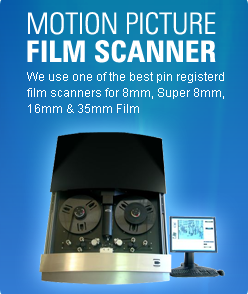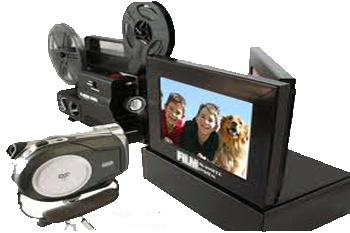
Film Conversion Equipment
Film Scanning and Film Transfer Equipment Types
The type of film scanning machine used for your 8mm, Super 8 or 16mm film conversion will have as much of an impact on the quality you receive as the resolution of the scan itself will. For example, if you wanted to digitize a photograph and tried doing it two different ways. You first put the photograph down on a table and took a picture of it using your smart phone or camera. Then you took the picture and scanned it using a flatbed scanner. If you compare the two side by side on your computer it will become really obvious that the flatbed scanner produced a digital image as good as the photograph. However, the picture you took with your phone or camera does not look close to the quality of the original photograph.
The same goes for scanning your 8mm, Super 8 or 16mm film. The real-time and frame by frame machines below are using a camcorder to take a picture of your film. The motion picture film scanner and Datacine machine are scanning the film. The results will be significantly different.
Film Conversion Equipment |
|
Real Time
|
|
Frame by Frame
|
|
Professional Film Scanners
|
|
Equally important as resolution is the type of film transfer. There are a few basic types of film transfer processes. More than 80% of the companies out there today use a real-time transfer. Any type of real-time film transfer will result in video that is 40-50% worse than the film’s current condition.
Frederick Fun Facts: Routes 15, 40, and 340. Founded in 1745 by English and German settlers, Frederick (originally called Fredericktown) began as a frontier town servicing wagon trains blazing the initial trails across the Allegheny Mountains. The starting place for the career of Star Spangled Banner poet Francis Scott Key, Frederick later became a natural crossroads for troop movements during the Civil War. Up until World War I, Frederick was largely a farming community and a local center for agricultural trade.
Maryland Fun Facts: Annapolis, the state capital, is also home to the United States Naval Academy. Maryland is the leading producer of blue crabs and is renowned for its crab cakes. One of the original 13 colonies, Maryland lies at the center of the Eastern Seaboard, amid the great commercial and population complex that stretches from Maine to Virginia. Its small size belies the great diversity of its landscapes and ways of life that they foster, from the low-lying and water-oriented Eastern Shore and Chesapeake Bay area, through the metropolitan Baltimore, its largest city, to the forested Appalachian foothills and mountains of its western reaches.








